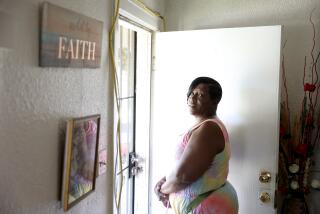ORANGE COUNTY IN BANKRUPTCY : Social Workers Say Children Will Suffer Most : Impact: They say current caseloads are all but unmanageable and cutbacks will mean more child abuse and neglect.
- Share via
SANTA ANA — With more than 70 children on his caseload, Gary Govett, a county social worker who tries to keep troubled families together, already counsels twice the number of families he should.
Govett, who works for the Children’s Services Department, is expected to visit every child in his caseload once a month as part of an attempt to prevent child abuse and neglect. When time allows, he does it. But when time is short, Govett simply doesn’t make it to some homes.
The situation would be made much worse by county Chief Executive Officer William J. Popejoy’s plan to cut $54 million from the Social Services Agency budget, eliminating 725 jobs and increasing caseloads for remaining social workers, such as Govett, far exceeding state targets.
“What I project would occur is that only the most dire needs, or the cases that erupt in crises, would be seen, and cases that aren’t obviously in need of attention would tend to get placed in the back in terms of priority,” Govett said.
“What that would mean is that a substantial number of cases which may have more complex or dire problems than initially observed would either go unnoticed, or children would be put at risk because of high-case levels,” he added.
County workers who investigate abuse of children and adults, support foster care families and oversee welfare payments would see their workloads rise sharply under Popejoy’s proposed budget cuts. But Social Services Director Larry Leaman agreed with Govett and other social workers that children will suffer most.
The number of child-abuse cases is up by 20% over a year ago, and Orangewood Children’s Home in January housed more children, 297, than at any other time in its history. When all the budget numbers are crunched, it is the children’s home that must brace itself because, experts agree, more children will end up there.
“If you’re a social worker, and you already have a very full load with 40 cases and then that goes up (substantially), well, you aren’t going to have the time to do quality work,” said Judy Nelson, executive director of the Orangewood Foundation, the nonprofit, fund-raising arm of the children’s home.
“There will be less time to find foster homes for children,” Nelson added, “so they’ll go to Orangewood. Social workers won’t have time to do any preventive work with families and so those kids will go to Orangewood--which is already fit to burst.”
Supervisor William G. Steiner, Orangewood’s former executive director, said he would fight to defeat Popejoy’s proposed social services cuts.
“The size of the cuts proposed for children’s services is absolutely unacceptable to me,” Steiner said. “I’m going to look at other areas in county government where we can cut so that we can add a degree of fairness to this.”
“It’s one thing for department heads to make recommendations and it’s fine for the CEO to look at them,” he said. “But ultimately the Board of Supervisors has to make the decision. I’m committed to making a $188-million cut, but not to the point of doing away with children’s services.”
Until the county declared bankruptcy in December, the Social Services Agency abided by state standards for the number of children a social worker should handle: an average of 35. The limit is a requirement for the county to receive state matching funds, Leaman said.
But because of the increase in the number of child-abuse cases and previous budget cuts prompted by the financial crisis, Orange County child abuse workers were preparing to carry an average of 52 cases by June, Leaman said. Under Popejoy’s proposal, they would carry an average of 82 cases each.
“With 52 cases, that means the worker has 2 1/2 hours per month per case,” Leaman said. “That’s all the time for paperwork, visits with foster care parents and court reports, handling phone calls related to the case.”
“It becomes pretty obvious that the requirements are not going to be met,” Leaman said.
Christine Ford, a senior social worker for the Parents and Children Together (PACT) program, which is part of the Children’s Services department, said she currently counsels about 30 children and their parents and is able to see each family once a week.
But if her workload increases, she and other counselors in the program would have to scrap individual meetings with families and see the children in groups, Ford said.
“These children and their parents have different problems and different needs,” Ford said. “If we do this counseling in group sessions, some of these children will be shortchanged.
The cuts “would put you at a situation where you couldn’t work enough hours, where you couldn’t work fast enough,” Ford said. “You would have to cut corners, and when you cut corners, the children are affected.”
Children notice when corners are cut, said Michael McKenzie, 23, a Saddleback College student who runs the peer support group at Orangewood, but who also stayed at the home four different times while growing up.
“My social worker was excellent, but I didn’t have a lot of contact with her and it was at a time where I really needed her reassurance that things were going to be OK,” he said.
“I’m worried about these cuts because when the social workers have to do too much, then you don’t get the attention you need,” he said. “It’s not their fault, but the quality just isn’t there. And for kids going through a difficult time, they need quality time and contact.”
More to Read
Sign up for Essential California
The most important California stories and recommendations in your inbox every morning.
You may occasionally receive promotional content from the Los Angeles Times.










